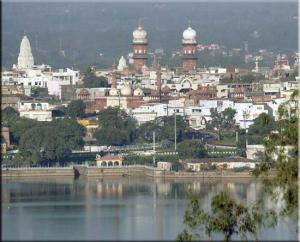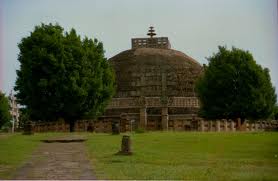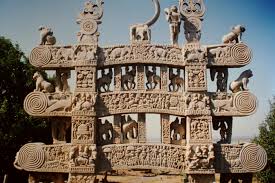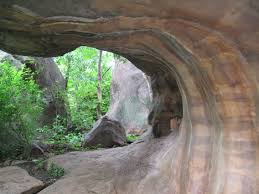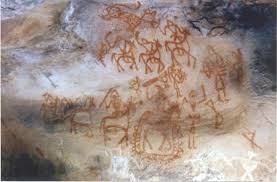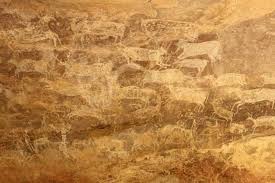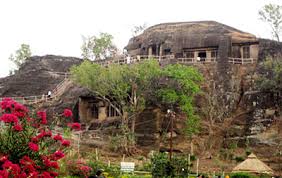Option 3 : Bhopal with Panchmarhi, Bhimbetka and Sanchi stupa
How to reach :
By Air : Bhopal is well connected through The Raja Bhoj International Airport
By Train: Bhopal Is well connected to all the major cities of India by a good network of express trains
By road : Bhopal is well connected by a network of National Highways
Things to do :
Bhopal : Bhopal is the capital of the Indian state of Madhya Pradesh. Bhopal is known as the City of Lakes for its various natural as well as artificial lakes and is also one of the greenest cities in India. Located on the Malwa plateau, it is higher than the north Indian plains and the land rises towards the Vindhya Range to the south. The city has uneven elevation and has small hills within its boundaries. The major hills in Bhopal are Idgah hills and Shyamala hills in the northern region, katara hills in south region and Arera hills in the central region. Apart from these Bhopal boosts of 2 lakes , the Bada talaab and the Chhota talaab. The main tourists spots that you may like to visit in Bhopal are :
Night View of Bada Talaab Bada Talaab city view
View of Bhopal from Bada Talaab
Bada Talaab
Bada Talaab : The Upper Lake of Bhopal or the Bada Taalab as it is more famously known is a huge water reservoir that lies in the Western part of the city. The lake is considered to be the biggest lake in Madhya Pradesh. Seeing this “Bada Talaab” one goes absolutely speechless. The lake is the major man-made drinking source for the residents of the city. This beautiful water reservoir is said to have existed since the 11th century. It is has a huge earthen embankment built across the Kolans River. The lake is visited not only for sight-seeing but also for customary beliefs as locals think its waters have the power to heal skin ailments. Apart from this, it is a favourite place among adventure lovers as it offers various sports activities such as paddling, rowing, and motorboats to indulge themselves.
Chota Talaab : The Lower Lake of Bhopal locally known as “Chhota Talab” is located in the tranquil surroundings of the magnificent hills. The lake is separated from the Upper Lake by an over-bridge. The lake has been preserved by MP tourism department since it is a beautiful remnant of the Mughal Empire. You can enjoy water sports here and also plan a get-together with the family.
Van Vihar National park : Adjacent to Upper Lake, Van Vihar National Park is an important sight-seeing spot of Bhopal. Developed and maintained by the zoological department, the park is spread roughly across 4.43 sq km of area. It came into existence in the year 1983. This national park is a strictly protected and vigilantly monitored zone. The national park has dense vegetation which is a suitable habitat for many species of animals and birds. Van Vihar National Park has over 300 species of animals, reptiles and birds. The major attraction of this national park is the white tiger. People from all over the world visit this place to see this exotic animal. The park features a beautiful landscape amidst the incredible world of animals and birds.
Lakshmi Narayan Temple : Constructed on the top of Arera Hills, the Lakshmi Narayan Temple in Bhopal radiates a pious aura. Also known as Birla Mandir, the temple is dedicated to the famous Goddess of wealth – Lakshmi. Built on a hilly terrain, the temple commands a panoramic sight over the city of Bhopal. Apart from Vishnu and Lakshmi, the temple also enshrines Shiva and Parvati. The tranquil atmosphere offers divine comfort to the visitors. The temple is also a museum where you would find beautiful collections of various sculptures that hail twelve centuries back. The place has a historic charm which makes it a must see feature while visiting Bhopal.
Taj-ul-Masjid Bhopal : Constructed in the 19th century, this Islamic mosque is situated in Bhopal. The Taj-ul-Masjid stands tall with pink bricks and elegant architecture making it one of the most significant sight-seeing spots in the city.
Moti Masjid is a beautiful mosque of Bhopal city visited by hundreds and thousands of Muslims every year from all corners of the country. The mosque is an important landmark of Bhopal and a magnificent shrine built by the ruler Sikander Begum in the year 1860.
Sanchi stupa Pillars at Sanchi stupa
Sanchi Stupa : Sanchi, the stupa village, is situated 45 km away from Bhopal. This place doesn’t need any introduction and is perhaps a well-known and must-see monument not only in India but also across the globe. The place is said to be one of the oldest stone structures of India and it edifies Buddhist remnants. It is one of the most visited Buddhist sites besides the Ashoka Pillar. The scenic landscaping and awesomely erected Buddhist landmarks at the place makes this site worth visiting.
It was Emperor Asoka who laid the foundations of a religious center at Sanchi fascinated probably by the location of the hill or because of his Queen Devi, who was the daughter of a merchant of Vidisha. He erected the Great Stupa (Stupa 1) here after redistribution of mortal remains of Lord Buddha for erecting several stupas all over the country in order to spread Buddhism.The place was sanctified by the visit of Mahendra, son of Asoka, who came to meet his mother Devi, perhaps living in one of the cells of the monastery located near Stupa 2, clothed in saffron cloths and a begging bowl in hand. It was from here, Mahendra, embarked on the missionary journey to Ceylon for propagating the message of the Buddha. From Ceylon, Buddhism spread to many countries of South East Asia such as Burma, Java, Sumatra, Thailand and Korea etc. Thus Sanchi is the proud mother of Buddhism to many South East Asian countries. There is so much to write about this ausoicious place that this blog will not be enough therefore suggest you go and visit it yourself and feel empowered by the vibrations of this place. Sanchi Stupa Is a world UNSECO Heritage site.
Reconstruction of PreHistoric time Rock Shelters at Bhimbetka
Rock shelters at Bhimbetka Rock shelters at Bhimbetka
Prehistoric time paintings at rock shelters Bhimbetka,
Bhimbetka :The Rock Shelters of Bhimbetka are located about 45 km south east of Bhopal on the road to Hoshangabad. The site spread over 10 km in length and about 3 km in width has more than 700 rock shelters, of which over 400 have paintings. Within massive sandstone outcrops, above comparatively dense forest, are five clusters of natural rock shelters, displaying paintings that appear to date from the Mesolithic Period right through to the historical period. The caves include the scenes from the everyday life, depicting household scenes, hunting, dancing, animal fighting, elephant riders, honey collections, body tattooing, music. Some of these paintings are estimated to be a hundred thousand years old (100,000 B.C.), and depict Early man hunting animals with the crudest stone implements, as is a characteristic of Paleolithic Era. Man used to live in the rock shelters of Bhimbetka, hunt down animals in the surrounding dense forests and paint scenes from his life onto the inner cave walls. The most ancient paintings are petroglyphs,being cut out of stone walls, while those painted some time later are red-coloured, the dye being made out of animal fat, plant roots and coloured earth. The Bhimbetka shelters exhibit the earliest traces of human life in India. More in store for you to explore and see how our ancestors evolved new practices using simple Laws of Life and everyday science. It Is also a World UNESCO Heritage site. Amazing Place indeed to relive Pre-historic times!
Reminants of Cyclopean Dam Bhojeshwar temple
Shiva Lingam at The temple
Bhojpur : Bhojpur is famous for the incomplete Bhojeśvar temple dedicated to Shiva. The temple houses one of the largest liṅgas in India. This temple which has earned the nomenclature of the Somnath of the east, is known as the Bhojeshwar Temple. The temple was never completed and the earthen ramp used to raise it to dome-level still stands. Also The Cyclopean dam which was a marvel during olden times; the great dam now lay in ruins on the western side of Bhojpur. To the West of Bhojpur once laid a vast lake which was destroyed by Hoshang Shah of Malwa (1405- 34).
Panchmarhi: Pachmarhi is a hill station in Madhya Pradesh state of central India. It is widely known as Satpura ki Rani (“Queen of Satpura”), situated at a height of 1100 m in a valley of the Satpura Range . Pachmarhi is blessed with very rich flora and fauna. It has endless nature spots, lush greenery, breath-taking views, waterfalls, mountain streams, rich and rare wildlife. Pachmarhi also has a lot of cave paintings in the forests, some of which have been estimated to be as much as 10,000 years old. Apart from the picturesque beauty of this hill station which boosts of the numerous waterfalls here. Panchmarhi also has of a number of tourist spots some of which are as below:
Pandav Caves
Pandhav Caves: An important tourist landmark in Panchmarhi, Pandav Caves lend their name to this picturesque hill resort of Madhya Pradesh. According to local legends and popular beliefs, the five Pandav brothers of Mahabharata, along with their wife ‘Draupadi’, spent a part of their exile here. However these are local legends only and these caves have nothing to do with Pandavs The 5 Pandav caves have been dug out of a hillock, which consisted of huge rocks. These caves are also believed to be about 2500 years old, by the locals. The steep man-made stairs, lead one to the entrance of the caves.
Water Falls at Panchmarhi
Jalawataran (Duchess Fall):The most beautiful of all Pachmarhi falls, it can be reached only on foot. The descent to the fall is steep and the journey is quite arduous. This fall plunges down in three different cascades, accompanied by deafening sounds. No doubt, the alluring sight and sound of the place makes it a hot spot amongst tourists
Rajat Prapat (Big Fall): A ten-minute walk from Apsara Vihar leads to the top of Rajat Pratap, the Big Fall. This fall is nearly 350 ft in height. It is a thrilling experience to watch straight down into the bottom of the fall, as it cascades its way from the high precipice. The journey that leads to the fall is bliss for the adventure-seekers.
Priyadarshini Point: Earlier known as Forsyth Point, it was named after Captain James Forsyth who discovered Panchmarhi from this point. Witnessing the spectacular sunset views from this vantage point, when the three peaks – Chauradeo, Mahadeo and Dhupgarh, play with various hues, is a privileged sight.
And many many more falls and spots for you to explore in Panchmarhi……….
Suggested itinerary : 3Nights/4 days
Day 1 : Arrive Bhopal and transfer to Panchmarhi , On the way, if time permits you may stop over at Bhojpur to see the remains of magnificent Shiva Temple and Cyclopean dam dated 1010-53 A.D. The tiny village of Bhojpur is situated on the bank of river Betwa. Check in at Hotel, Day at leisure or you ma just explore th hill station on foot
Day 2 : After Breakfast explore the hill station visiting various interesting spots and beautiful waterfalls mentioned above. Overnight at Panchmarhi
Day 3: After Early breakfast, onward jorney to Bhopal, enroute visit Bhimbetka, evening at leisure or you may go for boat ride at Bada talab
Day 4 : After Breakfast , proceed to one of the oldest stupas of India, Sanchi Stupa which was built 2000 years ago. Return to your hotel in the afternoon, freshen up and then leave for a visit to Sadar Manzil, Moti Masjid, the Upper and Lower Lakes., Later in the evening take your onward jorney to your destination
Approximate package cost with accommodation in a budget hotel with Breakfast for 3 Nights / 4Days will be Rs 18990 for a couple


